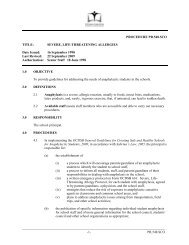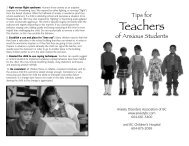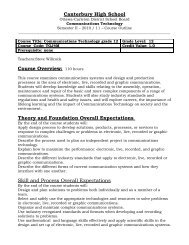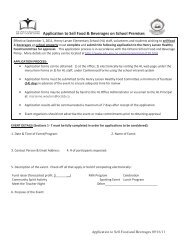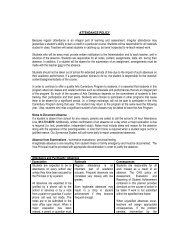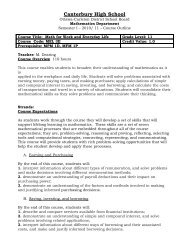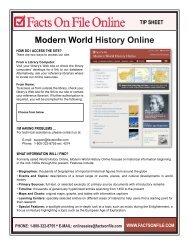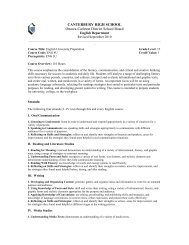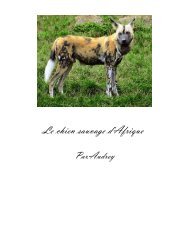Canterbury High School Style Guide Guidelines for Writing Essays ...
Canterbury High School Style Guide Guidelines for Writing Essays ...
Canterbury High School Style Guide Guidelines for Writing Essays ...
Create successful ePaper yourself
Turn your PDF publications into a flip-book with our unique Google optimized e-Paper software.
<strong>Canterbury</strong> <strong>High</strong> <strong>School</strong> <strong>Style</strong> <strong>Guide</strong><br />
<strong>Guide</strong>lines <strong>for</strong> <strong>Writing</strong> <strong>Essays</strong> and Independent Study Projects (ISPs)<br />
2010-2011<br />
sources:<br />
Hacker, Diana Humanities: Documenting Sources. Bed<strong>for</strong>d/St.Martin’s, 2010. Web. 30 Aug. 2010<br />
< http://bcs.bed<strong>for</strong>dstmartins.com/resdoc5e/RES5e_ch08_s1-0001.html ><br />
Hacker, Diana. Canadian Writer’s Reference, 2 nd ed. Toronto: Nelson Canada, 1996. Print.<br />
Table of Contents<br />
The three keys to a good essay 1<br />
A Thesis Statement 2<br />
Researching your Topic 2<br />
Parenthetical Citations 2-3<br />
The Bibliography/Works Cited 3-5<br />
Proof-reading 5<br />
Rules <strong>for</strong> <strong>for</strong>matting the paper 5-6<br />
General Notes regarding Major Projects/Independent Studies 6<br />
Example of a typical title page 6<br />
Academic Integrity and Plagiarism 6-7<br />
The three keys to a good essay or independent study<br />
Use research from a variety of places, showing that you have looked <strong>for</strong> in<strong>for</strong>mation, statistics, data and quotes<br />
from a number of sources. Do not fall into the trap of getting more than a few of your many sources from the World Wide<br />
Web. A well researched paper includes in<strong>for</strong>mation from a variety of media such as books, encyclopaedia, government<br />
publications, films, personal interviews, telephone calls and yes… even your classroom textbook! Extensive research from a<br />
variety of sources cannot be started 48 hours be<strong>for</strong>e the due date. In fact you must complete, and meet the deadlines of, all of<br />
the required PROCESS elements of your ISP. Following the process of the ISP is essential in getting feedback about how you<br />
are progressing with your research, <strong>for</strong>mulating arguments, and tying them together to prove the thesis. In short, the best<br />
advice is to START EARLY.<br />
Remember that you are not researching a topic in order to describe a subject. Your goal is to ANALYSE, and<br />
reflect on a research question or thesis topic. One of the most common problems found in many essays at this level is that<br />
students describe a subject chronologically, but show little reflection regarding the subject.<br />
Write in your own words, using language to the best of your ability. This will require re-writing and editing<br />
sections a number of times. So, once again, be sure to start early.<br />
Note: While this <strong>Style</strong> <strong>Guide</strong> is to be used by all <strong>Canterbury</strong> students in all subject areas, specific departments and courses<br />
may have additional requirements that must also be followed.<br />
Choosing a topic<br />
Good essay topics do not just appear… unless your teacher gives you a list. Even then, an appropriate question or a good<br />
thesis statement needs some preliminary research to get you started. Encyclopaedia, textbooks, parents, and teachers are all<br />
good beginning sources <strong>for</strong> essay subjects and research projects. Be sure to choose a specific topic or else you will find<br />
yourself stuck without any clear goals or direction <strong>for</strong> your research.
A Thesis Statement<br />
A thesis statement, believe it or not, is similar to a hypothesis used in science. In both cases, you make a statement regarding<br />
what you expect to find once you have finished your work. Note that there is no right or wrong conclusion regarding a thesis<br />
statement. The strength of your conclusion depends totally on your ability to defend that viewpoint. This is where good<br />
research skills come in handy.<br />
A good thesis statement is, in fact, an introductory paragraph that includes:<br />
1. a general and brief description of the subject about which you will be writing.<br />
2. a very brief plan or outline of how you will prove your point (generally, a summary of 3 arguments)<br />
3. a statement of what you expect to find or conclude.<br />
Each department will have their own respective requirements <strong>for</strong> <strong>for</strong>mulating a thesis statement <strong>for</strong> their research<br />
project/essay.<br />
Remember that a good thesis statement takes time, research and reflection. This is why your teacher asks <strong>for</strong> your essay in<br />
stages/phases and helps you to prepare a quality piece of work. In general, you must follow the required PROCESS elements<br />
of the ISP in order to receive feedback.<br />
Researching your topic<br />
Whatever method you use to collect data, it needs to be organised in a fashion that will allow you to retrieve in<strong>for</strong>mation,<br />
authors, quotations, or bibliographic data in a quick and orderly manner. If you do not, you may be scrambling late in the ISP<br />
process to put the paper together.<br />
Be sure to make use of any ideas that will help you organise your research by cataloguing in<strong>for</strong>mation.<br />
It is essential that you use a system that helps you keep track of:<br />
1. bibliographic data such as author, title, publisher, date of publication, or URL<br />
2. page numbers<br />
3. which portion of the topic is covered in the in<strong>for</strong>mation (different coloured hi-lighters work well in this case).<br />
*This process will save you a tremendous amount of time later in the process; otherwise, locating your own earlier research<br />
material/sources might prove very time consuming.<br />
Parenthetical Citations (in-text)<br />
Parenthetical Citations MUST be included in your research paper i.e. (Smyth 82).<br />
An Independent Study Project handed in without the use of parenthetical citations and/or a bibliography is considered incomplete.<br />
<strong>Canterbury</strong> <strong>High</strong> <strong>School</strong> requires students to use the parenthetical citation style <strong>for</strong> referencing sources of in<strong>for</strong>mation in a<br />
research paper/ISP essay. For a complete guide, you may consult:<br />
Hacker, Diana. Humanities: Documenting Sources: MLA in-text Citations. Bed<strong>for</strong>d/St.Martin’s,<br />
2010. Web. 30 Aug. 2010 <br />
For parenthetical citations in ENGLISH and SOCIAL SCIENCE, use the following in<strong>for</strong>mation as a guideline:<br />
• In almost all cases, the first word (s) of the bibliographic entry are used (see pages 3, 4, 5), as this is what the reader refers<br />
to, should he or she wish more in<strong>for</strong>mation regarding a given author or source.<br />
• In the citation, never place a comma between the author/title and the page number.<br />
• Whether the citation comes in the middle of a sentence or at the end of a short quote, the punctuation comes after the<br />
parentheses. Thus, the citation reads as part of the sentence. For longer quotes, see the next page.<br />
• The author and page number (if available) is included. The same <strong>for</strong>mat goes <strong>for</strong> print and electronic sources in order of<br />
precedence: author (if available), title (if author is NOT available), with page number.<br />
EXCEPTION: <strong>for</strong> papers written <strong>for</strong> SCIENCE classes only, parenthetical citations consist of the author’s last name and<br />
the date of publication i.e. (McKenna, 2010).<br />
Here are a few examples (bolded <strong>for</strong> emphasis only) that are drawn from fictitious sources using the <strong>for</strong>mat <strong>for</strong> English and Social Science:<br />
Based on the bibliographic entry: Smith, Joe. Violent Weather Phenomena. Ottawa: <strong>Canterbury</strong> Press, 2010. Print.<br />
one would see a parenthetical citation in a geography paper of:<br />
Research shows that winds inside a tornado may exceed 400 kilometres an hour (Smith 76).<br />
Where the author’s name is stated in the essay, it would be redundant to include it a second time in parentheses:<br />
Jones reports that most Third World deaths in children are due to malnutrition (176).<br />
2
Where there is neither an author nor a page number provided, as is often found on the World Wide Web, one only includes the<br />
first few words of the bibliographic entry (title –either underlined as below or in “quotation marks” if an article). Such an<br />
entry from the source: Supernatural Phenomenon. 5 Feb. 1994. Web. 9 Mar 2010 <br />
would appear as:<br />
There were several hundred reported sightings of UFOs in Canada last year (Supernatural).<br />
--------------------------------------------------------------------------------------------------------------------------<br />
When a quotation is longer than four typed lines of prose or three lines of verse, set it off from the text by indenting the entire<br />
quotation one inch (or ten spaces) from the left margin. Quotation marks are not needed when a quotation has been set off<br />
from the text by indenting.<br />
Example:<br />
In a debate one advocate stated the following in favour of the re<strong>for</strong>m of the Canadian Senate:<br />
What does our Upper House actually offer, apart from a com<strong>for</strong>table retirement package<br />
until the age of 75? When is the last time that this non-elected body rejected a bill from<br />
the Lower House? Certainly the Senate should be one that is equal, effective and elected.<br />
Anything short of that is undemocratic, irresponsible and contrary to the regional interests of the<br />
country. (Burns 134)<br />
When a quotation is less than four lines, quotation marks are used around the quotation and the period comes after the<br />
parenthetical notation.<br />
Example:<br />
In advocating stricter fines <strong>for</strong> dangerous driving, one observer describes being passed by another driver who “was<br />
holding a coffee cup and a cigarette in one hand, and a cellular telephone in the other, and appeared to have a<br />
newspaper balanced on the steering wheel” (Smith 80).<br />
The Bibliography/Works Cited<br />
Please use the expression Bibliography or Works Cited as specified by the department <strong>for</strong> whom you are writing your research<br />
project/essay. Be sure to ask your teacher which <strong>for</strong>mat they prefer.<br />
Use the following style examples given below and keep in mind the following rules when you write your bibliography/works cited:<br />
• the bibliography/works cited is in alphabetical order by author (or title, if no author), with no numbering<br />
• there is a double space between each entry<br />
• the entry itself is single spaced if longer than one line<br />
• if an entry has more than one line, the second line is indented five spaces to set off the name of the author or title<br />
• underline titles of books or encyclopaedia, or magazines, but “titles of articles” from magazines, newspapers or<br />
encyclopaedia are in quotation marks<br />
• always start with the author’s name, if it is not given, start with the title<br />
Here are a number of examples. Most are not drawn from real sources. This is based on the MLA documentation <strong>for</strong> the<br />
Humanities. In the future when writing research papers/essays in college or university, be sure to follow the particular <strong>for</strong>mat<br />
requested there. When choosing sources, be sure to select ACADEMIC sources that have been properly peer reviewed by<br />
persons with academic qualifications. AVOID using open-source encyclopaedias such as Wikipedia that can be edited/altered<br />
by almost any anonymous person <strong>for</strong> wholly non-academic reasons or because entries are not properly reviewed by academics.<br />
Print books:<br />
Book with one author:<br />
Atwood, Margaret. Alias Grace: A Novel. New York: Doubleday, 1996. Print.<br />
Book with two authors (note: the second name is not inverted):<br />
Sillman, Erik and Alex B. Harber. Walking in Mountainous Terrain. Toronto: Hilltop Books, 1999. Print.<br />
Book with three or more authors:<br />
Franks, John, et al. The War of 1812, from an American viewpoint. New York: Beacon Publishing, 1986. Print.<br />
Book with translator:<br />
Allende, Isabel. Daughter of Fortune. Trans. Margaret Sayers Peden. New York: Harper, 2000. Print.<br />
Magazine article:<br />
Hébert, Edouard. “The Myth of Grizzly Bear Attacks.” Field and Stream. 30 May 1993: 67. Print.<br />
3
Newspaper article with no author and with one author:<br />
“Nile River Virus in Canada.” Ottawa Citizen. 24 Apr. 1992: A6. Print.<br />
Birch, Tim. “Government lowers taxes on smokes.” Toronto Sun. 5 Dec. 1998: A3. Print.<br />
Newspaper editorial:<br />
"All Wet." Editorial. Boston Globe 12 Feb. 2001: 14. Print.<br />
Encyclopaedia and On-line Encyclopaedia:<br />
“World War I.” Encyclopaedia Canadiana: 2010. Print.<br />
(the second date shows when you accessed the document on-line)<br />
"Ho Chi Minh." Britannica. Encyclopaedia Britannica, 2010. Web. 15 May 2010. .<br />
Government publication:<br />
Canada. Statistics Canada. Historical statistics on the four founding provinces.<br />
Ottawa: Minister of Supply and Services Canada, 2009. Print.<br />
Sacred/Religious text: Give title of the edition (taken from the title page); the editor's name (if any); and publication in<strong>for</strong>mation.<br />
Holy Bible: New Living Translation. Wheaton: Tyndale, 1996. Print.<br />
Personal interview (or telephone interview) and e-mail:<br />
Ford, Harold. Researcher, Statistics Canada. Personal Interview. Ottawa. 19 Mar. 2010.<br />
O'Donnell, Patricia. "Re: Interview questions." E-mail to the author.15 Mar. 2009.<br />
Lecture or Public Address:<br />
Cohran, Kelan. “Astronomy.” Adler Planetarium, Chicago. 21 Feb. 2001. Lecture.<br />
Map or Chart and an on-line map:<br />
Ontario. Map. Kingston: Canadian Automobile Association, 1997. Print.<br />
“Serbia”. Map. Syrenna Maps. Syrenna, 2 Feb. 2001. Web. 17 Mar. 2009 .<br />
Pamphlet:<br />
Canada. Parks Canada. Hiking Trails of the Bruce Peninsula. Ottawa: Ministry of Supply and Services<br />
Canada, 2010. Print.<br />
***With the web site sources listed below the SECOND date shows the date that YOU accessed the in<strong>for</strong>mation.***<br />
<strong>for</strong>mat:<br />
author: last name first. Title of Web Site. Sponsor of the site/Personal page, date of update. Medium. Date of access: inverted. <br />
(n.d. = no date given <strong>for</strong> update date)<br />
Web Site with author<br />
Peterson, Susan Lynn. The Life of Martin Luther. Susan Lynn Peterson, 2005. Web. 24 Jan. 2009.<br />
.<br />
Web Site with no Author:<br />
Margaret Sanger Papers Project. History Dept., New York U, 18 Oct. 2000. Web. 3 Apr. 2010<br />
.<br />
Web Site with No Title:<br />
Yoon, Mina. Home page. Oak Ridge Natl. Laboratory, 28 Dec. 2006. Web. 12 Jan. 2009. <br />
Web Site with organization (Group) as author:<br />
United States. Environmental Protection Agency. Values and Functions of Wetlands. 2006. Web.<br />
24 Mar. 2010 .<br />
On-line newspaper article:<br />
Trout, Karen. “Angry Anglers harass Minister.” MontrealGazette.com. Montreal Gazette, 22 Mar. 1998<br />
Web. 30 Aug. 2010. .<br />
On-line article with no author:<br />
"Beginner Tip: Presenting Your Page with <strong>Style</strong>." Webmaster Tips Newsletter. NetMechanic.<br />
July 2000. Web. 13 Oct. 2008 .<br />
On-line magazine article:<br />
Marshall, Leon. "Mandela in Retirement: Peacemaker without Rest." National Geographic.com.<br />
National Geographic, 9 Feb. 2001. Web 13 Mar. 2010 .<br />
4
On-line Book:<br />
Rawlins, Gregory J. E. Moths to the Flame. MITpress.org. Massachusetts Institute of Technology, 1996.<br />
Web. 3 Apr. 2010 .<br />
Court Case: Name the first plaintiff and the first defendant. Then give the volume, name, and page number of the law report; the court<br />
name; the year of the decision; and publication in<strong>for</strong>mation (n.d. = no date given <strong>for</strong> update date)<br />
Utah v. Evans. 536 US 452. Supreme Court of the US. 2002. Supreme Court Collection. Legal In<strong>for</strong>mation Inst.,<br />
Cornell U Law <strong>School</strong>, n.d. Web. 30 Apr. 2010. <br />
Work found by a search service such as EBSCO host:<br />
Barrera, Rebeca María. "A Case <strong>for</strong> Bilingual Education." Scholastic Parent and Child Nov.-Dec. 2004:<br />
72-73. Academic Search Premier - EBSCOhost. Web. 1 Feb. 2009 .<br />
Work of Art (on-line):<br />
Hessing, Valjean. Caddo Myth. 1976. Joslyn Art Museum, Omaha. Joslyn Art Museum. Web.<br />
19 Apr. 2010. .<br />
Cartoon:<br />
Keefe, Mike. “Content of Character.” Cartoon. Denverpost.com. Denver Post, 28 Aug. 2008. Web. 12 Dec.<br />
2009. <br />
Musical Compostion (Score):<br />
Adler, Richard and Jerry Ross. "Whatever Lola Wants" Damn Yankees. Miami: CCP Belwin,<br />
1983: 76-81. Print.<br />
Sound Recording:<br />
Bizet, Georges. Carmen. Perf. Jennifer Laramore, Thomas Moser, Angela Gheorghiu, and Samuel Ramey.<br />
Bavarian State Orch. and Chorus. Cond. Giuseppe Sinopoli. Warner, 1996. CD.<br />
Podcast downloaded as a digital file:<br />
“Calculating the Demand <strong>for</strong> Charter <strong>School</strong>s.” Narr. David Guenthner. Texas PolicyCast. Texas Public<br />
Policy Foundation, 28 Aug. 2008. MP3 file<br />
Entry in a wiki NOTE:A wiki is an online reference that is openly edited by its users. Because wiki content is, by definition, collectively edited and can be updated frequently, do not include an author in the<br />
entry. As the origins of the in<strong>for</strong>mation on these sites cannot be fully traced and/or peer reviewed by persons of academic standing, do NOT use these sources <strong>for</strong> any significant portion of major research papers (ISPs).<br />
“Hip Hop Music.” Wikipedia. Wikimedia Foundation, 26 Sept. 2008. Web. 18 Mar. 2010.<br />
<br />
Posting to an online discussion list:<br />
Fainton, Peter. “Re: Backlash against New Labour.” Media Lens Message Board. Media Lens, 7 May<br />
2008. Web. 2 June 2010. .<br />
Television: title of TV episode, title of TV Program, producer, network, station, city of broadcast, date of broadcast, medium.<br />
"Monkey Trial." American Experience. Prod. Martin Smith. PBS. WGBH, Boston. 18 Mar. 2003. Television.<br />
Radio or Television Interview:<br />
McGovern, George. Interview by Charlie Rose Charlie Rose PBS. WNET, New York. 1 Feb. 2001. Television.<br />
Film:<br />
Finding Neverland. Dir. Marc Forster. Perf. Johnny Depp, Kate Winslet, Julie Christie, Radha Mitchell, and<br />
Dustin Hoffman. Miramax, 2004. Film.<br />
Book or film review:<br />
Gleick, Elizabeth. "The Burdens of Genius." Rev. of The Last Samurai, by Helen DeWitt. Time<br />
4 Dec. 2000: 171. Print.<br />
Advertisement:<br />
Truth by Calvin Klein. Advertisement. Vogue Dec. 2000: 95-98. Print.<br />
Proof-reading your Essay<br />
Here are a few tips on proof-reading your essay.<br />
• Do not leave proof-reading to the last minute. You should proof-read at least once out loud. You should proof-read on<br />
two or three different occasions, and not when you are over tired.<br />
• Do not rely on your spellchecker to correct all mistakes. i.e. the difference between words such as “its” and “it’s”!<br />
• Ask someone else to read your paper, not just <strong>for</strong> grammar and spelling, but also <strong>for</strong> style and fluidity.<br />
• Be sure to include transitional words and statements which refer back to your thesis.<br />
5
Rules <strong>for</strong> Formatting Your Paper<br />
The list of items below is crucial to a complete and well-written essay. Check to make sure that you have met all of the<br />
specifications:<br />
• all papers should be word processed (typed)<br />
• use 8.5 ” x 11” white paper<br />
• double space the document (with the exception of block quotes)<br />
• use 12 font (Times New Roman or Arial fonts)<br />
• use standard margins of 2.5 cm at the top and bottom and 3 cm from left and right<br />
• the title on the title page is in 18 font, centred on the page; your name, the course, the date and the teacher’s name are to<br />
be in 12 font in the bottom right-hand corner<br />
• <strong>for</strong>eign terms or phrases are to be italicised<br />
• no titles, subtitles, indexes nor table of contents are to appear in the research project/essay<br />
• appendices are added at the end of the essay, but be<strong>for</strong>e the bibliography/works cited<br />
• appropriate appendices could include such material as maps, diagrams, charts, tables or pictures<br />
• all material in appendices is referenced with a parenthetical citation.<br />
• <strong>for</strong> appendices, only use in<strong>for</strong>mation to which you have referred in your essay<br />
• use standard paragraphing with a five space indent, do not leave extra spaces between paragraphs<br />
• do not use any contractions (which means that you will NEVER use the word it’s in an essay/research project)<br />
• use Canadian/British spelling of words (i.e. neighbour and NOT neighbor).<br />
• titles in text follow the same rules as they appear in the bibliography/works cited<br />
• all pages after the first page must be numbered (excluding the bibliography/works cited)<br />
• in a <strong>for</strong>mal essay, never write in the first person (me, I, my)<br />
General Notes regarding Major Research Projects/Independent Studies<br />
• At the senior level if a student fails to hand in the independent study or any part of its process, he/she is deemed not have<br />
met the expectations associated with that particular grading activity of the course. An "incomplete" or an eventual zero<br />
may be assigned if it is not submitted by the final marking deadline (see CHS Assessment/Evaluation Policies 2010-11).<br />
• The required PROCESS of the ISP must match the final paper.<br />
• An independent study handed in without a bibliography/works cited and parenthetical notation is considered incomplete.<br />
• Please follow the rules that your specific department or teacher might have <strong>for</strong> handing in your final paper.<br />
Example of a Title Page<br />
(Note that the title is 18 font, centred on the page. Also note that the in<strong>for</strong>mation in the bottom corner is LEFT justified – and<br />
that this would normally take up an entire page)<br />
Clayoquot Sound:<br />
A Case Study in Temperate De<strong>for</strong>estation<br />
Submitted by: David Smyth<br />
Submitted to: Ms. Macdonald<br />
Course: Canadian and World Issues (CGW4U)<br />
Due Date: April 30, 2010<br />
The following is from: <strong>Canterbury</strong> <strong>High</strong> <strong>School</strong>, Assessment, Evaluation, and Reporting of Student Achievement in your student agenda<br />
Academic Integrity<br />
• Students are expected to produce and take credit <strong>for</strong> their own work.<br />
• Fraudulent work is of no value and provides zero evidence of a student’s learning. Parents/guardians will be contacted in such cases.<br />
• Academic dishonesty includes but is not limited to copying someone else’s work, cheating, citing references incorrectly, and handing in<br />
the same assignment <strong>for</strong> more than one course. Such dishonesty will have a behavioural consequence and the student will have an<br />
opportunity to redo the assignment or complete an alternate task. A mark of zero may be assigned if the student does not produce<br />
evidence of learning.<br />
• Fraudulent work will be documented and archived.<br />
6
What is plagiarism?<br />
Plagiarism<br />
Plagiarism comes from the Greek plagios, meaning deceitful and later from the Latin, plagiarius meaning kidnapper. Both<br />
origins are insightful when looked at together. Plagiarism means taking something that does not belong to you, or using it in a<br />
deceitful manner. Plagiarism has come to refer to the use of someone else’s words or ideas without giving credit to the source<br />
of in<strong>for</strong>mation. In short, it is a <strong>for</strong>m of theft.<br />
Failure to recognise the use of others’ work could result in a mark of zero or a teacher could ask you to re-write the entire<br />
paper (within the original deadline). A good essay has numerous parenthetical citations, because in a standard essay most of<br />
the in<strong>for</strong>mation comes from a variety of legitimate academic sources that help support your viewpoint.<br />
Types of plagiarism<br />
Students tend to believe that plagiarism means copying something verbatim from a book or from the World Wide Web. This<br />
is, however, a very limited view of the problem. There are many <strong>for</strong>ms of plagiarism.<br />
1. Copying an entire essay from a web site or using someone else’s essay that may or may not have been submitted to a<br />
teacher at an earlier date.<br />
2. Copying a paragraph or cutting and pasting to create an essay from a variety of sources.<br />
3. Quoting a source but continue using the source after closing the quotation marks.<br />
4. Replacing a few words here and there without actually putting it in your own words or<br />
5. Paraphrasing without giving credit to the author.<br />
6. Making up quotes that do not exist often to meet a teacher’s requirement of a certain number of quotes or citations.<br />
7. Taking someone else’s idea, even if it is in your own words, and putting it <strong>for</strong>th as your own insight or conclusion.<br />
8. Including a chart, photo, or graph in your research paper without acknowledging its source.<br />
9. Including a statistic, definition or data in the essay without acknowledging its source.<br />
10. Translating a quote from another language without giving credit to the author.<br />
11. Using a video, audio recording or other multi-media without giving credit to the author or producer.<br />
12. Using a quote from a secondary source without acknowledging the original source. Every ef<strong>for</strong>t should be made to retrieve<br />
the primary source, but if you cannot, the student is to reference the source that he/she has used.<br />
13. “Borrowing” a paragraph or an idea without giving credit to the original source or author is just as wrong as copying a<br />
whole essay. Neither is acceptable.<br />
How to avoid plagiarism<br />
1. Make every ef<strong>for</strong>t to use parenthetical citations throughout your paper. Examples of parenthetical citation are provided earlier in<br />
this document. For their College/University Studies, senior students may wish to purchase a copy of the MLA or APA <strong>Guide</strong>lines <strong>for</strong><br />
essay writing or refer to <br />
Always use the required <strong>for</strong>mat!<br />
2. Put things in your own words, and certainly not sentence by sentence. You need to paraphrase. This means taking the general<br />
idea and putting it in your own words. You still need to indicate the source in parenthetical citation. Paraphrasing does not mean<br />
changing two or three words in a sentence. That is still plagiarism.<br />
3. As you do your research, keep an accurate and complete record of all the sources that you used. Also note pages of quotes right<br />
away or the URL so that you do not have to go hunting <strong>for</strong> the quotation in your final stages of essay writing. In this way, your<br />
bibliography will be complete and accurate when you have finished your dissertation.<br />
4. NEVER cut and paste from the web. It is much better to print out all relevant documentation that you may wish to re-read and hilight.<br />
This material may be used to paraphrase some key ideas or in<strong>for</strong>mation.<br />
5. Most students <strong>for</strong>get to indicate the source of statistics and data. If you use numbers, make sure you know where they<br />
came from and give credit to the person or organisation that carried out the research or polls to collect the data.<br />
6. Many students like to add maps, photos, diagrams, charts, drawings, or images in appendices at the end of an essay. If you do,<br />
make sure that you make reference to the material in the actual essay i.e.: (See Appendix A). Also indicate all sources of such<br />
material using proper parenthetical citation.<br />
7. As you take notes, put in quotation marks everything that you have copied directly from the text. Note its source and page.<br />
8. Do not use vocabulary that you do not understand. This is part of the task of putting the in<strong>for</strong>mation in your own words.<br />
Using your own vocabulary ensures you understand what you have written.<br />
9. If you are able to write a first draft of your essay without using your original notes, this will help you take ownership of the topic<br />
IN YOUR OWN WORDS and see what you think about it. At the point where you want to insert supporting facts/ideas/quotations,<br />
leave a blank or put in the parenthetical citation with the source's name if you can remember it.<br />
Overall, be sure to start early, research widely from academic sources, and analyse in<strong>for</strong>mation in your own words in order to<br />
produce a quality product that you will be proud of as well as create a deeper understanding of your research topic.<br />
7



